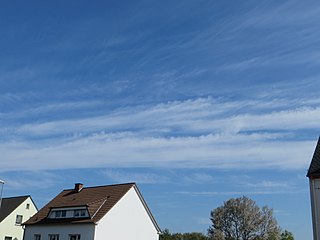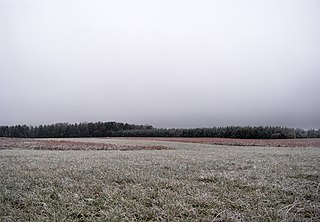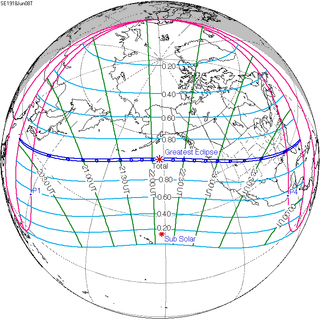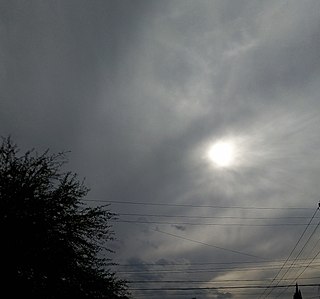
In celestial mechanics, the Lagrange points are points of equilibrium for small-mass objects under the gravitational influence of two massive orbiting bodies. Mathematically, this involves the solution of the restricted three-body problem.

Cirrus is a genus of high cloud made of ice crystals. Cirrus clouds typically appear delicate and wispy with white strands. Cirrus are usually formed when warm, dry air rises, causing water vapor deposition onto rocky or metallic dust particles at high altitudes. Globally, they form anywhere between 4,000 and 20,000 meters above sea level, with the higher elevations usually in the tropics and the lower elevations in more polar regions.

In meteorology, a cloud is an aerosol consisting of a visible mass of miniature liquid droplets, frozen crystals, or other particles suspended in the atmosphere of a planetary body or similar space. Water or various other chemicals may compose the droplets and crystals. On Earth, clouds are formed as a result of saturation of the air when it is cooled to its dew point, or when it gains sufficient moisture from an adjacent source to raise the dew point to the ambient temperature.

Altocumulus is a middle-altitude cloud genus that belongs mainly to the stratocumuliform physical category characterized by globular masses or rolls in layers or patches, the individual elements being larger and darker than those of cirrocumulus and smaller than those of stratocumulus. However, if the layers become tufted in appearance due to increased airmass instability, then the altocumulus clouds become more purely cumuliform in structure. Like other cumuliform and stratocumuliform clouds, altocumulus signifies convection. A sheet of partially conjoined altocumulus perlucidus is sometimes found preceding a weakening warm front, where the altostratus is starting to fragment, resulting in patches of altocumulus perlucidus between the areas of altostratus. Altocumulus is also commonly found between the warm and cold fronts in a depression, although this is often hidden by lower clouds.

Altostratus is a middle-altitude cloud genus made up of water droplets, ice crystals, or a mixture of the two. Altostratus clouds are formed when large masses of warm, moist air rise, causing water vapor to condense. Altostratus clouds are usually gray or blueish featureless sheets, although some variants have wavy or banded bases. The sun can be seen through thinner altostratus clouds, but thicker layers can be quite opaque.

A stratocumulus cloud, occasionally called a cumulostratus, belongs to a genus-type of clouds characterized by large dark, rounded masses, usually in groups, lines, or waves, the individual elements being larger than those in altocumulus, and the whole being at a lower height, usually below 2,000 metres (6,600 ft). Weak convective currents create shallow cloud layers because of drier, stable air above preventing continued vertical development. Historically, in English, this type of cloud has been referred to as a twain cloud for being a combination of two types of clouds.

Stratus clouds are low-level clouds characterized by horizontal layering with a uniform base, as opposed to convective or cumuliform clouds formed by rising thermals. The term stratus describe a flat, hazy, featureless clouds at low altitudes varying in color from dark gray to nearly white. The word stratus comes from the Latin prefix strato-, meaning "layer". Stratus clouds may produce a light drizzle or a small amount of snow. These clouds are essentially above-ground fog formed either through the lifting of morning fog or through cold air moving at low altitudes. Some call these clouds "high fog" for their fog-like form.

Sunset is the disappearance of the Sun below the horizon due to Earth's rotation. As viewed from everywhere on Earth, it is a phenomenon that happens daily except in areas close to the poles in their respective winters. The equinox Sun sets due west at the moment of both the spring and autumn equinoxes. As viewed from the Northern Hemisphere, the Sun sets to the northwest in the spring and summer, and to the southwest in the autumn and winter; these seasons are reversed for the Southern Hemisphere.

The sky is an unobstructed view upward from the surface of the Earth. It includes the atmosphere and outer space. It may also be considered a place between the ground and outer space, thus distinct from outer space.

A shadow is a dark area where light from a light source is blocked by an object. It occupies all of the three-dimensional volume behind an object with light in front of it. The cross section of a shadow is a two-dimensional silhouette, or a reverse projection of the object blocking the light.

Atmospheric diffraction is manifested in the following principal ways:

Within the atmospheric sciences, atmospheric physics is the application of physics to the study of the atmosphere. Atmospheric physicists attempt to model Earth's atmosphere and the atmospheres of the other planets using fluid flow equations, chemical models, radiation budget, and energy transfer processes in the atmosphere. In order to model weather systems, atmospheric physicists employ elements of scattering theory, wave propagation models, cloud physics, statistical mechanics and spatial statistics which are highly mathematical and related to physics. It has close links to meteorology and climatology and also covers the design and construction of instruments for studying the atmosphere and the interpretation of the data they provide, including remote sensing instruments. At the dawn of the space age and the introduction of sounding rockets, aeronomy became a subdiscipline concerning the upper layers of the atmosphere, where dissociation and ionization are important.

The night sky is the nighttime appearance of celestial objects like stars, planets, and the Moon, which are visible in a clear sky between sunset and sunrise, when the Sun is below the horizon.

A circumhorizontal arc is an optical phenomenon that belongs to the family of ice halos formed by the refraction of sunlight or moonlight in plate-shaped ice crystals suspended in the atmosphere, typically in cirrus or cirrostratus clouds. In its full form, the arc has the appearance of a large, brightly spectrum-coloured band running parallel to the horizon, located far below the Sun or Moon. The distance between the arc and the Sun or Moon is twice as far as the common 22-degree halo. Often, when the halo-forming cloud is small or patchy, only fragments of the arc are seen. As with all halos, it can be caused by the Sun as well as the Moon.

A total solar eclipse occurred on Saturday, June 8, 1918. The eclipse was viewable across the entire contiguous United States, an event which would not occur again until the solar eclipse of August, 2017.

Cirrus spissatus or also called Cirrus densus and Cirrus nothus clouds are the highest of the main cloud genera, and may sometimes even occur in the lower stratosphere. The characteristic features of cirrus clouds are fine threads or wisps of ice crystals, generally white, but appearing grey when dense and seen against the light. There is no precipitation at the ground. It also frequently exhibits optical phenomena.

Stratus nebulosus is a species of low-level stratus cloud. It is one of only two species that is associated with stratus clouds, other being fractus. Translated from Latin meaning nebulous, their cloud abbreviations can be respectively written as ‘St neb’. For a cloud to be classified as nebulosus, there has to be zero sign of detail in the cloud.

Translucidus is a cloud variety, it appears in altocumulus, altostratus, stratus, and stratocumulus clouds, this cloud variety is very recognizable, with its only feature being that it is translucent, and gives away the location of the Sun and Moon, and sometimes, it lets stars in the night sky be visible, it is the opposite of the cloud variety opacus, which isn't translucent, but opaque.

Perlucidus is a cloud variety that generally appears in only two cloud types, with those cloud types being altocumulus and stratocumulus, this cloud variety is easily recognizable, with its appearance being small gaps showing up in one of the cloud types that it shows up in, which let higher clouds be seen This cloud variety forms when shallow convection starts in a cloud layer that did not previously have perlucidus variety characteristics, the gaps that make the sky visible in these clouds indicate regions where air is sinking, this cloud variety may appear either as a translucent cloud or an opaque cloud


















